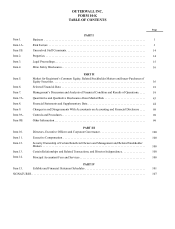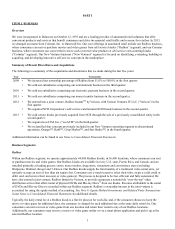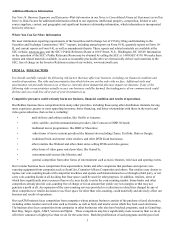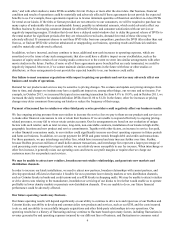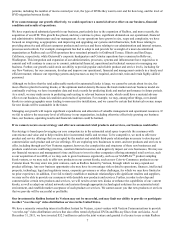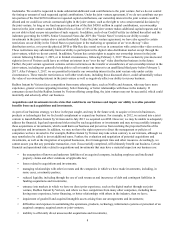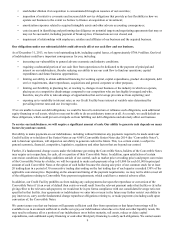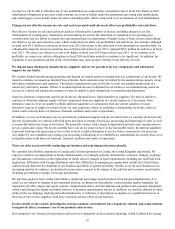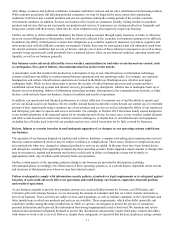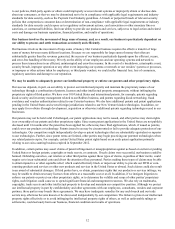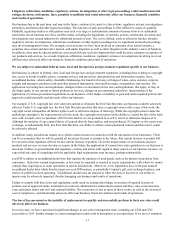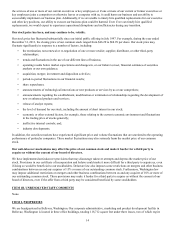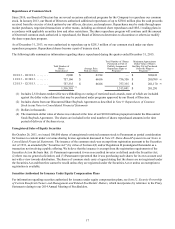Redbox 2013 Annual Report Download - page 18
Download and view the complete annual report
Please find page 18 of the 2013 Redbox annual report below. You can navigate through the pages in the report by either clicking on the pages listed below, or by using the keyword search tool below to find specific information within the annual report.9
• stockholder dilution if an acquisition is consummated through an issuance of our securities;
• imposition of restrictive covenants and increased debt service obligations that provide us less flexibility in how we
operate our business to the extent we borrow to finance an acquisition or investment;
• amortization expenses related to acquired intangible assets and other adverse accounting consequences;
• costs incurred in identifying and performing due diligence on potential targets and negotiating agreements that may or
may not be successful, including payment of break-up fees if transactions are not closed; and
• impairment of relationships with employees, retailers and affiliates of our business and the acquired business.
Our obligations under our substantial debt could adversely affect our cash flow and our business.
As of December 31, 2013, we have total outstanding debt, including capital leases, of approximately $766.9 million. Our level
of indebtedness could have important consequences for you, including:
• increasing our vulnerability to general adverse economic and industry conditions;
• requiring a substantial portion of our cash flow from operations to be dedicated to the payment of principal and
interest on our indebtedness, thereby reducing our ability to use our cash flow to fund our operations, capital
expenditures and future business opportunities;
• limiting our ability to obtain additional financing for working capital, capital expenditures, product development, debt
service requirements, share repurchases, acquisitions and general corporate or other purposes;
• limiting our flexibility in planning for, or reacting to, changes in our business or the industry in which we operate,
placing us at a competitive disadvantage compared to our competitors who are less highly leveraged and who,
therefore, may be able to take advantage of opportunities that our leverage prevents us from exploiting; and
• exposing us to variability in interest rates, as our Credit Facility bears interest at variable rates determined by
prevailing interest rates and our leverage ratio.
If we are unable to meet our debt obligations, we could be forced to restructure or refinance such obligations, seek additional
equity financing or sell assets, which we may not be able to do on satisfactory terms or at all. As a result, we could default on
those obligations, which could prevent or impede us from fulfilling our debt obligations and adversely affect our business.
To service our indebtedness, we will require a significant amount of cash. Our ability to generate cash depends on many
factors beyond our control.
Our ability to make payments on our indebtedness, including without limitation any payments required to be made under our
Credit Facility or to holders of the Senior Notes or our 4.00% Convertible Senior Notes due 2014 (the “Convertible Notes”),
and to fund our operations, will depend on our ability to generate cash in the future. This, to a certain extent, is subject to
general economic, financial, competitive, legislative, regulatory and other factors that are beyond our control.
Further, if a fundamental change occurs under the indenture governing the Convertible Notes, holders of the Convertible Notes
may require us to repurchase, for cash, all or a portion of their Convertible Notes. In addition, upon satisfaction of certain
conversion conditions (including conditions outside of our control, such as market price or trading price) and proper conversion
of the Convertible Notes by a holder, we will be required to make cash payments of up to $1,000 for each $1,000 in principal
amount of such Convertible Notes at the option of each holder because the closing sale price of our common stock for at least
20 trading days in a period of 30 consecutive trading days ending on the last trading day of such quarter exceeded 130% of the
applicable conversion price. Depending on the amount and timing of the payment requirements, we may not be able to meet all
of the obligations relating to Convertible Note payment requirements, which could have a material adverse effect.
In addition, our Credit Facility prohibits us from making any cash payments due upon the repurchase or conversion of the
Convertible Notes if (i) an event of default then exists or would result from the relevant payment under that facility or (ii) after
giving effect to the relevant cash payment, we would not be in pro forma compliance with our consolidated leverage ratio test
specified in that facility. Any agreements or indebtedness we enter into or incur in the future may further restrict our ability to
pay interest on, carry out the fundamental change repurchase obligations relating to, or make payments (including cash) upon
conversion of, the Convertible Notes.
We cannot assure you that our business will generate sufficient cash flow from operations or that future borrowings will be
available to us in an amount sufficient to enable us to pay our indebtedness when due or to fund our other liquidity needs. We
may need to refinance all or a portion of our indebtedness on or before maturity, sell assets, reduce or delay capital
expenditures, seek additional equity financing or seek other third-party financing to satisfy such obligations. We cannot assure


